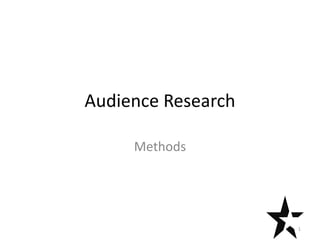
Audience Research Methods Guide
- 2. Primary research Primary research is research that you create yourself This could be by carrying out interviews and getting people to respond to questionnaires It can involve both qualitative and quantitative research Positives: You can tailor your research to get the information you need You can ask additional questions during interviews Negatives: It can take a long time to set-up, gather and collate information Finding reliable respondents can be difficult 2
- 3. Secondary research Secondary research involves looking at existing material It allows you to look at resources that have already been created It could also involve both qualitative and quantitative research Positives: The research is already out there. All you have to do is sift through it. There are a wide range of resources available Negatives: The research may not be entirely suited to your needs You are reliant on the accuracy and integrity of other researchers work 3
- 4. Your primary research could involve getting people to answer a questionnaire . You could then conduct an interview with someone who regularly reads a magazine in your chosen genre or who is a fan of the music you will make. Using primary research You can use primary research to: Ask specific questions that only a fan can answer Get a more intimate insight into the tastes of an audience Ask any questions that you could not find answers to Use the interview to confirm your findings from your secondary research To gather feedback on a finished product 4
- 5. Using secondary research You can use secondary research to: Analyse existing products Find out about a magazines readership Understand more about a music scene/genre Identify the mise en scene of the genre Identify key bands or artists within that genre 5 You have already carried out some secondary research by looking at existing products. Try to find out more about the audience for those products. The publishers website might contain information that could help you.
- 6. Questionnaires A questionnaire is a research tool containing a series of questions for the purpose of gathering information. Advantages Questionnaires are cheap to do They do not require much effort from the questioner as they often have standardised answers that make it simple to compile data The wording should be kept simple: no technical or specialised language. 6 Questionnaire
- 7. 7 Interview Interviews are a more personal form of research than questionnaires. Advantages The interviewer works directly with the respondent. The interviewer has the opportunity to probe or ask follow up questions. Interviews are useful if what is sought is opinions or impressions Disadvantages Interviews can be time consuming and they are resource intensive It is harder to collate the data
- 8. Closed questions A closed question is one which can be answered using a simple yes or no, a specific piece of information or a selection from a multiple choice. Examples: How old are you? Where do you live? Why might we use them? They are easy to answer. They are quick to answer. They keep control of the conversation with the questioner. They give information you can use in a chart or graph 8
- 9. Open questions 9 An open question is one which deliberately seeks longer answers and is the opposite of a closed question. Examples: What is it like where you live? What do you feel about politics? Why might we use them? They ask the respondent to think and reflect. They will give you opinions and feelings. They hand control of the conversation to the respondent.
- 10. Quantitative research Quantitative research is used to measure the number of people who feel, think or act in a particular way. It is usually the result of closed questions. The results can then be used as statistics. This information can then be used to create charts and graphs to illustrate the findings. The research can be broad and wide ranging in who it targets or may be aimed at a more specific demographic. Questionnaires often produce quantitative research 10
- 11. Qualitative research Qualitative research is used to measure how people feel. It is usually the result of open questions. The results give a wide range of answers and the results can be hard to use as statistics. Results of interviews and focus groups are examples of qualitative research. 11
- 12. Vox Pops These are the voice of the people. You normally ask one open question. You have a specific way of setting the camera up. 12
- 13. • ....DownloadsVox Pops Examples.avi
- 14. Survey Monkey www.surveymonkey.com 14 Survey Monkey is a quick, easy and FREE! way of getting responses to your questionnaire. Once you have created your questionnaire you can post it anywhere on the internet, for example your blog. Survey Monkey will collate the information for you as well, you just have to interpret it. It also saves paper.
- 15. Research advice To get the best results from your research you will need to use a mix of techniques to collect information. Use both quantitative and qualitative research methods. Ensure your research is aimed at your target audience and is appropriate to them. There is no point collecting information on fans of classical music if you are making a magazine for an audience who listens to metal. Think about how the research can help influence your project. What do you need to know? Your research should have an influence on the plans you make for your magazine. 15